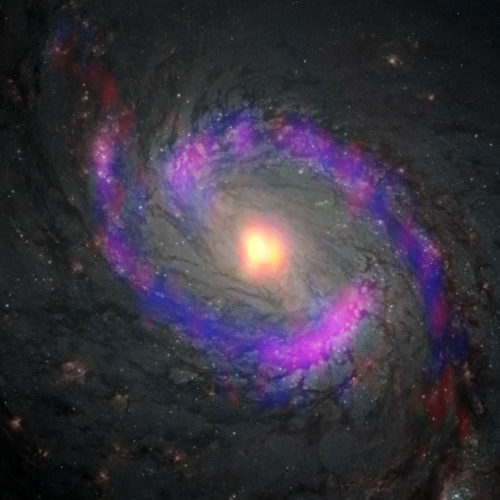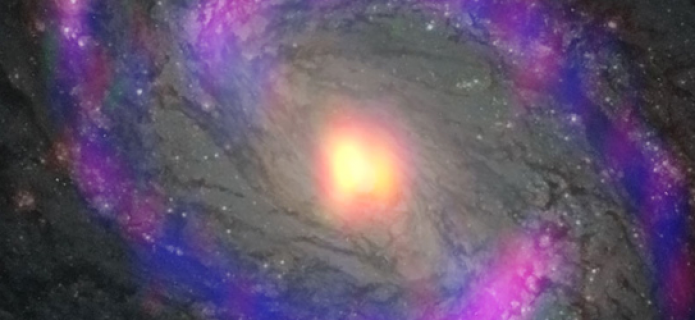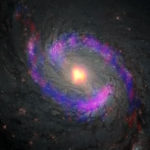ALMA Revealed Calm Pockets Protecting Organic Molecules
Researchers using the Atacama Large Millimeter/submillimeter Array (ALMA) have discovered regions where certain organic molecules somehow endure the intense radiation near the supermassive black hole at the center of galaxy NGC 1068, also known to amateur stargazers as M77.
Such complex carbon-based molecules are thought to be easily obliterated by the strong X-rays and ultraviolet (UV) photons that permeate the environment surrounding supermassive black holes. The new ALMA data indicate, however, that pockets of calm exist even in this tumultuous region, most likely due to dense areas of dust and gas that shield molecules from otherwise lethal radiation.

The central part of the galaxy M77, also known as NGC 1068, observed by ALMA and the NASA/ESA Hubble Space Telescope. Yellow: cyanoacetylene (HC3N), Red: carbon monosulfide (CS), Blue: carbon monoxide (CO), which are observed with ALMA. While HC3N is abundant in the central part of the galaxy (CND), CO is mainly distributed in the starburst ring. CS is distributed both in the CND and the starburst ring. Credit: ALMA(ESO/NAOJ/NRAO), S. Takano et al., NASA/ESA Hubble Space Telescope
Molecules Reveal Clues to Galactic Environments
Interstellar gas contains a wide variety of molecules and its chemical composition differs widely depending on the environment. For example, an active star forming region with a temperature higher than the surrounding environment stimulates the production of certain types of molecules by chemical reactions which are difficult to take place in a cold temperature region. This enables researchers to probe the environment (temperature and density) of a target region by studying the molecular chemical compositions in it. Since each molecule has its own frequency spectrum, we can identify the chemical composition and the environment of a remote target object through observations with a radio telescope.
From this perspective, astronomers have been actively working on the starburst regions of galaxies [1] and the surrounding region of the active galactic nuclei (AGN) at the center of galaxies, called circumnuclear disk (CND) [2]. These regions are very important in understanding the evolution of galaxies, and radio observations of molecular emissions are essential to explore its mechanism and environment [3]. However, the weak radio emission from molecules often made the observations difficult and took many days for signal detection using conventional radio telescopes.
ALMA Observations Trace Molecules
A research team led by Shuro Takano at the National Astronomical Observatory of Japan (NAOJ) and Taku Nakajima at Nagoya University observed the spiral galaxy M77 in the direction of the constellation of Cetus (the Whale) about 47 million light years away with ALMA. M77 is known to have an active galactic nucleus at its center which is surrounded by a starburst ring with a radius of 3500 light years.
Since the research team had already conducted radio observations of various molecular emissions in this galaxy with the 45 meters telescope at the Nobeyama Radio Observatory of NAOJ, they aimed to develop their research further with ALMA's extreme sensitivity, high-fidelity and ability to observe wideband in multiple wavelenght along with a high spatial resolution; and identify the difference in chemical composition between AGNs and starburst regions.

The central part of the galaxy M77, also known as NGC 1068, observed by ALMA and the NASA/ESA Hubble Space Telescope. Yellow: cyanoacetylene (HC3N), Red: carbon monosulfide (CS), Blue: carbon monoxide (CO), which are observed with ALMA. While HC3N is abundant in the central part of the galaxy (CND), CO is mainly distributed in the starburst ring. CS is distributed both in the CND and the starburst ring. Credit: ALMA(ESO/NAOJ/NRAO), S. Takano et al., NASA/ESA Hubble Space Telescope
ALMA observations clearly revealed the distributions of nine types of molecules in the circumnuclear disk and in the starburst ring. "In this observation, we used only 16 antennas, which are about one-fourth of the complete number of ALMA antennas, but it was really surprising that we could get so many molecular distribution maps in less than two hours. We have never obtained such a quantity of maps in one observation," says Takano, the leader of the research team.
The results show that the molecular distribution varies according to the type of molecule. While carbon monoxide (CO) is distributed mainly in the starburst ring, five types of molecules, including complex organic molecules such as cyanoacetylene (HC3N) and acetonitrile (CH3CN) are concentrated in the circumnuclear disk. In addition, carbon monosulfide (CS) and methanol (CH3OH) are distributed both in the starburst ring and the circumnuclear disk. ALMA provided the first high resolution observation of the five types of molecules in M77 and revealed that they are concentrated in the circumnuclear disk.
Shielding Complex Organics around a Balck Hole
The supermassive black hole devours surrounding materials by its strong gravity and generates such a hot disk around him that it emits intense X-rays or UV photons. When complex organic molecules are exposed to strong X-rays or UV photons, their multiple atomic bonds are broken and the molecules destroyed. This is why the circumnuclear disk was thought to be a very difficult environment for organic molecules to survive. ALMA observations, however, proved the contrary: Complex organic molecules are abundant in the circumnuclear disk.
"It was quite unexpected that acetonitrile (CH3CN) and cyanoacetylene (HC3N), which have a large number of atoms, are concentrated in the circumnuclear disk," said Nakajima.
The research team assumes that organic molecules remain intact in the circumnuclear disk due to a large amount of gas, which act as a shield from X-rays and UV photons, while organic molecules cannot survive the exposure to the strong UV photons in the starburst region where the gas density is lower.
The researchers point out that these results are a significant first step in understanding the structure, temperature, and density of gas surrounding the active black hole in M77. "We expect that future observations with wider bandwidth and higher resolution will show us the whole picture of our target object in further detail and achieve even more remarkable results," says Takano.
"ALMA has launched an entirely new era in astrochemistry," said Eric Herbst of the University of Virginia in Charlottesville and a member of the research team. "Detecting and tracing molecules throughout the cosmos enables us to learn so much more about otherwise hidden areas, like the regions surrounding the black hole in M77."
These observation results were published as Takano et al. "Distributions of molecules in the circumnuclear disk and surrounding starburst ring in the Seyfert galaxy NGC 1068 observed with ALMA" (in the astronomical journal Publications of the Astronomical Society of Japan (PASJ), issued in July 2014) and as Nakajima et al. "A Multi-Transition Study of Molecules toward NGC 1068 based on High-Resolution Imaging Observations with ALMA" (in PASJ issued in February 2015).
Notes
[1] In the Milky Way Galaxy which we live in, one sun-like star is generated per year on average, while several hundred sun-like stars are churned out each year in a starburst region.
[2] It is believed that most of the galaxies have in their center a supermassive black hole of millions to hundreds of millions of solar mass. Among them, Active Galactic Nuclei (AGN) represents a type of supermassive black hole which are gulping down surrounding gas very actively and emitting some amount of gas as high-speed gas flows (jets).
[3] For example, a research team led by Takuma Izumi and Kotaro Kohno at the University of Tokyo, both of whom are engaged in this research, suggests that there is enhanced emission of hydrogen cyanide (HCN) from the supermassive black hole in the barred spiral galaxy NGC1097 by the past ALMA observations.
Reference: October 24, 2013, Press release "Unique Chemical Composition Surrounding Supermassive Black Hole—A Step toward Development of New Black Hole Exploration Method"
This research was conducted by: Shuro TAKANO (NAOJ Nobeyama Radio Observatory/SOKENDAI); Taku NAKAJIMA (Solar-Terrestrial Environment Laboratory, Nagoya University); Kotaro KOHNO (Institute of Astronomy, The University of Tokyo/Research Center for the Early Universe); Nanase HARADA (Academia Sinica Institute of Astronomy and Astrophysics [At the time of writing: Max Planck Institute for Radio Astronomy]); Eric HERBST (University of Virginia); Yoichi TAMURA (Institute of Astronomy, The University of Tokyo); Takuma IZUMI (Institute of Astronomy, The University of Tokyo); Akio TANIGUCHI (Institute of Astronomy, The University of Tokyo); Tomoka TOSAKI (Joetsu University of Educaction).
More information
The Atacama Large Millimeter/submillimeter Array (ALMA), an international astronomy facility, is a partnership of the European Organisation for Astronomical Research in the Southern Hemisphere (ESO), the U.S. National Science Foundation (NSF) and the National Institutes of Natural Sciences (NINS) of Japan in cooperation with the Republic of Chile. ALMA is funded by ESO on behalf of its Member States, by NSF in cooperation with the National Research Council of Canada (NRC) and the Ministry of Science and Technology (MOST) in Taiwan and by NINS in cooperation with the Academia Sinica (AS) in Taiwan and the Korea Astronomy and Space Science Institute (KASI).
ALMA construction and operations are led by ESO on behalf of its Member States; by the National Radio Astronomy Observatory (NRAO), managed by Associated Universities, Inc. (AUI), on behalf of North America; and by the National Astronomical Observatory of Japan (NAOJ) on behalf of East Asia. The Joint ALMA Observatory (JAO) provides the unified leadership and management of the construction, commissioning and operation of ALMA.
Contact:
Nicolás Lira
Education and Public Outreach Assistant
Joint ALMA Observatory
Santiago, Chile
Tel: +56 2 467 6519
Cell: +56 9 9445 7726
Email: [email protected]
Masaaki Hiramatsu
Education and Public Outreach Officer, NAOJ Chile
Observatory Tokyo, Japan
Tel: +81 422 34 3630
E-mail: [email protected]
Charles E. Blue
Public Information Officer
National Radio Astronomy Observatory
Charlottesville, Virginia, USA
Tel: +1 434 296 0314
Cell: +1 434.242.9559
E-mail: [email protected]
Richard Hook
Public Information Officer, ESO
Garching bei München, Germany
Tel: +49 89 3200 6655
Cell: +49 151 1537 3591
Email: [email protected]


